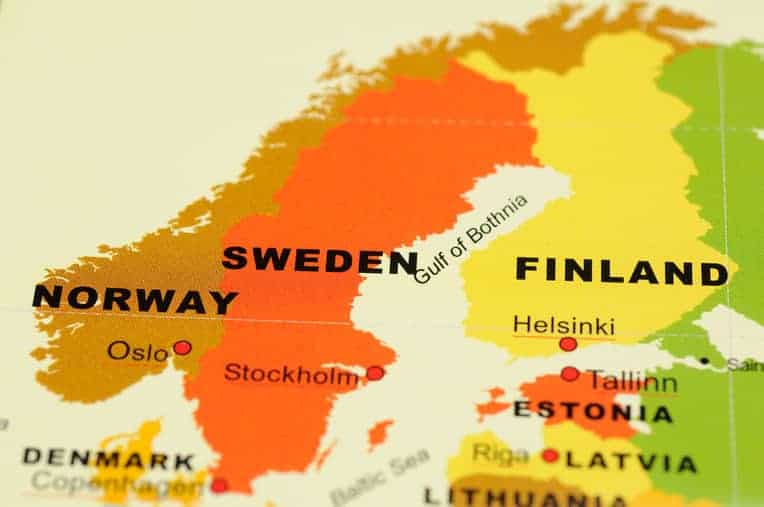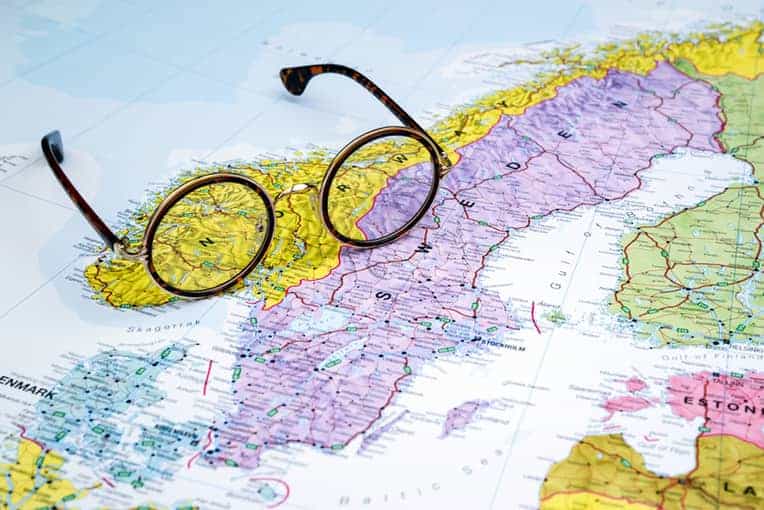Because Scandinavia is a name that refers to a geographic location in the world, many are curious about the people who live there. One common question is if “Scandinavia” describes a particular race of people.
The answer to the question—Is Scandinavia a race?—is debated.
Some believe that since the people that makeup Scandinavia have historical, linguistic, and cultural commonalities, they fit the definition of a “race.”
Others, citing the differences among the people of Scandinavia, argue they are not.
Understanding what countries make up the area known as Scandinavia is an important part of the question. Traditionally, Norway, Sweden, and Denmark make up the region called “Scandinavia.”
However, because of historical, linguistic, and cultural commonalities, Iceland, Finland, and the Faroe Islands are often also considered a part of “Scandinavia,” as the word is commonly used in the English language.
The region of Scandinavia is one of the happiest places on Earth. See Why Are Scandinavian Countries So Happy? to learn more.

Racial makeup of Scandinavian countries
The common definitions of the word “race” refer to a group of people who are related by common ancestry, including, but not limited to, languages, histories, genetics, and cultural traits. [1] [2]
Some argue that the people of Scandinavia fit this description. Yet others, citing the differences between Norwegians, Swedish, and Danish, in particular, believe they don’t.
Scandinavian countries are homogeneous, which means there isn’t a lot of racial diversity in each country:
- Denmark: Danes make up 90% of the population.
- The Faroe Islands: Faroese people make up almost 100% of the population. They are one of the most homogeneous people groups in the world [3]
- Finland: Finns make up 93.4% of the population.
- Iceland: Icelanders make up 91.4% of the population.
- Norway: Norwegians make up 87% of the population.
- Sweden: Swedes make up 88% of the population.
Most languages in Scandinavia are mutually intelligible, meaning that if a person speaks Danish, they are likely to understand Norwegian.
If a person speaks Swedish, they are likely to understand Danish, and so on. The major exception to this is Finnish, which has a different language base.
Diversity of language in Scandinavia
Language is an important factor in what constitutes a race of people.
While the people of Northern Europe mostly speak North Germanic languages, which are rooted in the Indo-European language base, there is some linguistic diversity as well.
Scandinavian countries don’t have as many minority races as some other countries in the world.
There are various reasons for this, which include geographical location, the availability of work, immigration patterns, the stability of neighboring nations, and more
Sami: For example, the Sami people, who are indigenous to parts of northern Norway, Sweden, and Finland, speak Sami, a language that is not part of the North Germanic language family.
Rather, Sami is part of the Uralic language base, which is not rooted in the Indo-European language family.
The Sami people, therefore, do not meet the linguistic criteria of considering whether a certain people group is part of a particular race of people.
However, the Sami are indigenous to the area of Northern Europe, so not including them in an ethnic category of “Scandinavian” seems unfitting to some people.
Finnish: For another example, most of the residents of Finland speak Finnish. Like the language of the Sami people, the Finnish language belongs to the Uralic language family, not the Indo-European language base. Historians aren’t clear on why Finnish is so different than other Scandinavian languages:
Several theories exist as to the geographic origin of Finnish and the other Uralic languages.
The most widely held view is that they originated as a Proto-Uralic language somewhere in the boreal forest belt around the Ural Mountains region and/or the bend of the middle Volga.
The strong case for Proto-Uralic is supported by common vocabulary with regularities in sound correspondences, as well as by the fact that the Uralic languages have many similarities in structure and grammar. [4]
In relation to linguistics, there are commonalities among the residents of Northern Europe, but the differences leave the question open for some.
Many people hear the name “Scandinavia,” but what exactly is it? See Is Scandinavia a Country, Continent, or Something Else? to learn more.

Is there a Nordic race?
Sometimes the name “Nordic” is used interchangeably with Scandinavian. In the past, some historians and anthropologists have identified a Nordic race of people.
Those who have identified a Nordic race, have classified the people of Northern Europe as a sub-race of the Caucasian ethnic group.
Joseph Denikker (1852-1918), a French anthropologist, is credited with coining the term “nordique,” meaning “northerner,” as it was used in reference to a race of people.
Others, like German anthropologist, Rudolf Virchow (1821-1902), disagreed with Denikker’s classification.
Some anthropologists that hold to a “Nordic race” classification, see other groups as part of the race, which are not conventionally considered part of Scandinavia, such as certain Germanic people groups as well as certain Celtic people groups.
Is there an Aryan race?
The name “Aryan” in modern usage is sometimes used in controversial contexts.
Historically, the word is defined as a member or descendant of the pre-historic people who spoke Indo-European.
Some anthropologists classify Aryans as a distinct sub-race of the Caucasian ethnic group; others, however, resist using the name altogether, arguing that the term is imprecise and unhelpful to scientific studies.
The term “Aryan race” was used in the 19th century to describe certain people groups of Northern Europe, which created controversy.
Max Muller (1823-1900), a German language historian, was one of the first to refer to the “Aryan race” in his writings, but he eventually disavowed the name as an anthropological classification. [5]
Joseph Arthur de Gobineau (1816-1882), on the other hand, a French novelist and diplomat, further developed the idea of the “Aryan race,” arguing that people of that racial classification were superior to other ethnic groups. [5]
Not surprisingly, this created great controversy.
Though some in Germany at the time embraced Gobineau’s teachings on race, his ideas were widely rejected by the scientific community for being ungrounded and not based on verifiable facts.
People accused Gobineau of hijacking words and terms that were used in anthropological and historical discussions, in order to further his personal social agenda and controversial beliefs.
The Encyclopedia Britannica summarizes:
In Europe the notion of white racial superiority emerged in the 1850s, propagated most assiduously by … de Gobineau and later by his disciple Houston Stewart Chamberlain, who first used the term ‘Aryan’ to mean the “white race.”
Members of that so-called race spoke Indo-European languages, were credited with all the progress that benefited humanity, and were purported to be superior to “Semites,” “yellows,” and “blacks.” [6]
In common English usage today, Aryan is sometimes used as a synonym for Scandinavian or Indo-European, even though that usage is imprecise and perhaps misleading.
It has not been always malicious in intent, however. For example, early 20th century editions of Rand McNally’s World Atlas identified Aryans as one of the world’s 10 major racial groups.
Some white supremacist groups have also adopted their terminology:
“In the late 20th and early 21st centuries, many white supremacist groups used the word Aryan in their name as an identifier of their racist ideology… That association with racism, crime, hate crimes, and Nazism has given the word a powerful new negative sense.” [7]
Danish, Norwegian, and Swedish people are similar, but how similar? See Is Scandinavia a race? to learn more.
Scandinavians as Caucasians
In the Western world, especially in the United States, Caucasian is often used as a synonym for “white,” a description that refers to light-colored skin.
Describing Caucasians as white didn’t originate in the United States, but dates back to the Roman Empire. [8]
Even though referring to people as white is common, it can cause confusion because there can be great ancestral diversity among “white” Americans, for example.
A “white” person’s heritage may have roots in northern Europe, like Scandinavia, or England, or Germany. Yet their family history could also be traced back to Australia, Asia, or Africa. [9]
When Americans are asked to identify their race, “white” is sometimes an option, and because of the demographics of the United States, it is often selected.
Most anthropologists, however, argue that the term is misleading and confusing because “white” is not a race.
On the other hand, some hold that the term is helpful because the ancestral makeup of many Americans includes more than one European country.
For example, one person may be part Irish, another part English, and another part German, Swedish or French. Using one term—”white”—is a catch-all that encompasses all such variations and combinations.
Where in the world is Scandinavia? See Is Scandinavia in Europe? to learn more.
References:
[1] Source
[2] Source
[3] Source
[4] Source
[5] Source
[6] Source
[7] Source
[8] Source
[9] Source
